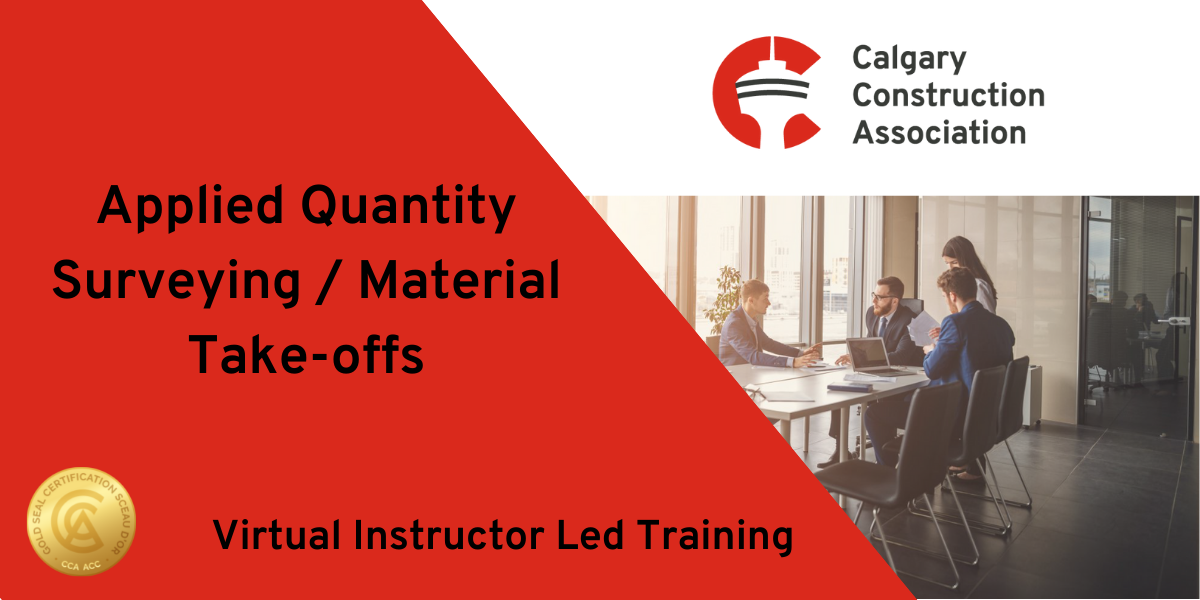
This practical, hands-on course will teach you how to complete accurate and consistent material take-offs for pricing or even ordering purposes. Using the example of a small commercial structure, attendees will complete a detailed and comprehensive quantity survey/material takeoff for items of work including earthwork, substructure, and superstructure. *Students should have a working knowledge of blueprint reading and be prepared to complete math exercises (calculating areas and volumes)
What is a quantity surveyor and what do they do?
In North America, the terms ‘quantity surveying,’ or ‘quantity surveyors,’ are synonymous with construction estimating or construction estimators. On the Canadian Institute of Quantity Surveyor’s (CIQS) website, a quantity surveyor is described as:
“Construction cost consultants/cost estimators [who] work for either the client or the contractor and can be based in an office or on-site. They make sure the costs of large construction and infrastructure projects are accurately estimated based on initial requirements and project specs.”
A quantity surveyors’ responsibility is to calculate the quantity of material needed to complete a project by surveying the construction documents and doing what we call a material ‘take off.’ However, the duties of a quantity surveyor are greatly expanded as they become experts in costing, cost analysis, estimating and project financing. In the CIQS’s introduction video, a quantity surveyor is depicted as: Part Architect, Part Engineer, Part Contractor, Part Lawyer, Part Accountant.
This course is worth 2 Gold Seal Credits
Applied Quantity Surveying / Material Take-offs will help you:
- Identify the origin of the items for quantification in a general contractor environment
- Describe the various standard practices and procedures used in the quantity surveying discipline
- Identify 10 steps to a successful take off
- Explain the mathematical principals behind basic quantity surveying processes
- Complete a detailed and comprehensive quantity survey for items of work including earthwork, substructure and superstructure for a small commercial structure
- Understand how the quantity survey dovetails to the eventual estimate.
CCA Member $949 (+GST) Non-Member $1199 (+GST)
Additional Details
Quantity surveying starts with determining the construction materials required to meet the job requirements by performing a materials take-off, which is a skill set in and of itself. This course will teach you how to apply the processes and procedures required to complete accurate and consistent material take-offs for pricing or even ordering purposes.
Using the example of a small commercial structure, attendees will complete a detailed and comprehensive quantity survey/material takeoff for items of work including earthwork, substructure, and superstructure. This isn’t a course where attendees sit back and listen – you’ll be expected to actively participate, and ‘learn by doing’ under the guidance of your course instructor. Your instructor will provide direction and examples of the various material take-offs, and then you’ll get to practice!
Course content will also cover:
- What is a quantity surveyor and what does he or she do
- Proper practices and procedures of quantity surveying
- General rules and methods of measurement of construction works
- How quantity surveys are organized and structured
- How the MasterFormat® system is used by quantity surveyors
- How items of construction are identified for quantity surveying
- Applied quantification of items of earthwork
- Applied quantification of items of concrete
- Applied quantification of items of formwork
- Applied quantification of items of concrete masonry units
*Please note that this course focuses on the basic principles of quantity surveying and not about how to use excel/software to perform takeoffs. Attendees will be provided with an excel spreadsheet to use in completing exercises, which they can also choose to print and complete manually on paper.
Blueprint Reading: You should have a working knowledge of blueprint reading before taking this course.
Math: Students will be provided with a sample set of blueprints, and you should be comfortable with/prepared to calculate areas and volumes based on information you locate in the blueprints.
New construction estimators, staff who assist with take-offs, field engineering staff or supervisors required to order materials as part of their responsibilities, industry professionals who want to learn how a quantity survey is completed, or those considering a career as a quantity surveyor will all benefit from this course.
This course is delivered in partnership between your local construction association and other associations throughout Western Canada. You’ll be participating in a cohort with industry peers from across these regions.

Ralph Lembcke, P.GSC
Ralph’s construction career has taken him from estimator to project manager, then to self-employed contractor, and finally to a 30-year career as a professor with the Donald J. Smith School of Building Technology at Fanshawe College in London, ON, where he still teaches part-time. He was a 25-year member of the Canadian Institute of Quantity Surveyor (PQS – Professional Quantity Surveyor) and is currently a charter member of the Construction and Design Educators Council of Canada (CDECC). Ralph sits on the board of advisors for the CDECC as well as for an Ontario-based construction company. Ralph holds a certificate in Construction Engineering Technology and Management from Fanshawe College, a teaching certificate from St. Clair College and a Professional Gold Seal certification from the Canadian Construction Association.
- Live, Online, Instructor-led training.
- This course is facilitated by the instructor on the Zoom platform. Access information will be provided to you in advance of the training.
- You will be expected to have your webcam on during the class and participate in group discussions and other activities with your instructor and classmates during the course.
- This course is delivered in partnership with local construction associations. You will be participating with a cohort of industry peers from multiple regions.
This workshop requires full face-to-face interaction and participation from both the instructor and students.
Please make sure you have the following:
- Computer or laptop with webcam: This course will involve on-screen interaction with your instructor and classmates, reading/viewing on-screen content like slides or videos, and interacting via typing with questions or responses. For this reason, we recommend that you have a full computer/laptop set-up and don’t recommend using a cell phone or tablet to attend the training.
- A quiet space with minimal distractions: plan to be fully engaged in the class and clear your work schedule just as you would for attendance in an in-class program.
Cancellation Policy:
Payment is non-refundable for cancellations made within 5 business days of the course, or non-attendance on the day. Complimentary substitution of another member of your company is accepted. If CCA has to postpone or cancel courses due to insufficient enrolment, CCA will refund the registration fee or, if possible, the attendee may choose to move to an identical session in the future. Unless otherwise stated, every person able to see, hear, and observe the virtual course sessions must be a paid participant. Non-compliance of this requirement will result in removal from course. Refunds will not be issued to students who are removed from the course for non-compliance of this requirement.
CANADA – ALBERTA JOB GRANT
Did you know!! Eligible employers can get government funding to help employees access training opportunities. The Canada-Alberta Job Grant will give you up to 2/3 of the registration fee (up to $10,000/employee/fiscal year) for training. Whether taking one course or a combination of courses, the total training must be a minimum of 21 hours and be completed within 52 weeks.
